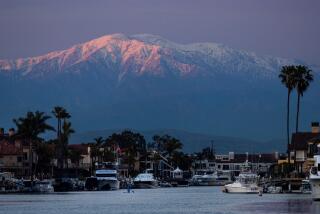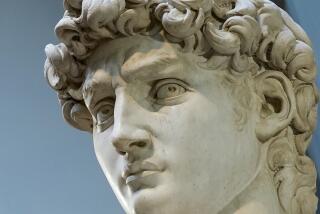600 Acres of City May Be Bulldozed for Archeological Park : Rome Could Drive Out Auto Traffic to Make Room for History
ROME--Mere mention of the plan gives Rome’s traffic managers nightmares. Politicians already mired in unmanageable deficits blanch at its cost. Most Romans think it may be a nice idea, but one that will probably never get off the ground.
The plan is the work of the man responsible for maintaining the city’s rich heritage of ancient monuments, and he is doggedly determined to take Rome back to a semblance of what it was in the past.
His radical proposition: to bulldoze entire streets and boulevards out of the way and turn more than 600 acres in the heart of Rome into a living museum, an archeological park free of traffic and free of the air pollution that destroys monuments. The area would then be open to extensive archeological excavation.
The man behind this grandiose scheme, Dr. Adriano La Regina, Rome’s superintendent of archeology, is responsible for the preservation of the world’s greatest collection of ancient monuments.
If he has his way, he will transform scores of acres of what is now traffic-choked asphalt, concrete and cobblestone into tree-lined lanes and walkways, and expose buildings and artifacts of Imperial Rome that are buried under modern streets and boulevards.
One of the city’s broadest boulevards, the Via Dei Fori Imperiali, which the late Benito Mussolini put down to link the Colosseum to the Piazza Venezia at the heart of the city, effectively buried much of Trajan’s and Augustus’ forums.
Another boulevard, the Via Dei Cerchi, cuts off the famous Circus Maximus, site of the fictional Ben Hur’s chariot race, from the archeologically rich Palatine hill where emperors lived. Streets and boulevards crisscross through and around the area, a mixture of the ages. Modern additions, such as the offices of the U.N. Food and Agriculture Organization, squat there like tombstones.
Noxious clouds of automotive pollutants rising from the overused pavements join with the fumes of heating oil and gas to eat away the surfaces of the ancient stone and marble monuments that have been excavated over the years. Traffic already has had to be diverted away from the stately Arch of Constantine and part of the Colosseum to save them from crumbling.
The trouble is that the main roadways La Regina wants to discard are among the most heavily used in Rome. The Piazza Venezia, for example, is the hub of all the major roads leading into the city center. A traffic jam there means gridlock for miles around. City planners have been tearing their hair for years over how to cope with too much traffic, never mind how to find and preserve what is buried there.
No problem, says the mild-mannered archeologist who has supervised the excavation and care of ancient Rome for the last decade. Several years ago, La Regina assembled a team of experts to study the idea of a traffic-free archeological park in all its ramifications, including how and where to reroute the traffic. The results, to be published this month in an elegant hard-cover book, leave little doubt that the plan is feasible if anyone wants to spend the money to do it.
“From a technical and scientific point of view,” La Regina said the other day as he thumbed through the book, “we have done what we needed to do: demonstrate that the idea will work. Now it is up to the politicians to decide.”
But will the politicians buy it, he was asked.
“We are only responsible for the quality of our proposal,” La Regina said with a shrug. “The politicians are responsible for the quality of their decisions.”
No one knows, he said, how much money would be involved in such a drastic transformation of the center of one of the world’s great cities. But he added that he does not see cost as a barrier. Nor should residents of the area mind, since no dwellings would be disturbed.
“It is nothing compared to what we spend for railroads and highways and so on,” he said. “Why can’t we consider our historical heritage as important as any other public work?”
The park plan calls for a new subway line (Rome now has two) skirting the greatest concentration of ruins, and a number of new roads that would leave the central archeological area free of traffic except for small shuttle buses.
“Our own costs, the archeological costs, would not be great,” La Regina said. “Our works are necessarily slow, drawn out over a long period of time, and they are not costly. What would cost are things that Rome needs anyway, things like the new subway and peripheral road links so that everyone doesn’t have to drive through the center of the city to get where he’s going.”
‘Era of Transformation’
Sooner or later, he said, the idea will take hold because “we are in an era of great transformation, comparable only to the years when the first law for the protection of monuments was passed (a century ago). Italians today are more conscious of their heritage, and the value of that heritage in terms of tourism is one of Italy’s great financial resources.”
As evidence that times are changing in respect to preserving Rome’s past, La Regina and other archeologists point proudly to the unprecedented amount of preservation and restoration accomplished in the last five years.
In 1981, under a special law, Parliament appropriated $180 million for an urgent program to halt the deterioration of the monuments, to restore them as much as possible and to look for new discoveries where possible. Before that appropriation, according to another archeologist, Dr. Marisa de Spagnolis, the amounts of money set aside each year for archeology were not enough even to maintain existing sites, much less preserve them.
The restoration program, originally scheduled to have been completed by last month, has gone more slowly than planned, to the chagrin of many Romans and countless visitors whose view of many of the city’s most famous landmarks has been blocked by shrouds of green plastic screening put up to protect the monuments and their restorers from the elements.
Monuments Under Wraps
The intricately carved columns of Trajan and Marcus Aurelius, for example, have been under wraps for more than three years, the Arch of Constantine for five, and half a dozen other sites, including the Arch of Septimius Severus in the Roman Forum, for almost as long.
La Regina said that about 100 skilled art restorers are at work on the shrouded monuments, and that most of these monuments are almost ready to be unveiled, some by the summer.
But the four most sought after by tourists and art lovers, the columns of Trajan and Marcus Aurelius and the Arches of Constantine and Septimius Severus, may remain under wraps for another three years or more, he said.
“There are problems that haven’t been resolved with them,” De Spagnolis said. “In some cases, we are still looking for the cause of the damage, so it is too early to say when they will be completed.”
La Regina said that “to restore means first of all to understand,” and added that the four most important monuments are also the most difficult to deal with because of their profusion of sculpted figures and reliefs.
New Protection for Column
The Marcus Aurelius column, which stands just off one of the busiest streets in downtown Rome, far removed from the proposed archeological park area, may have to be permanently housed in a tower of glass to protect it from pollution, he said.
Meanwhile, it and the others require protective chemical coatings of various sorts, depending on the cause and extent of damage, before they can be stripped of their green plastic shrouds and exposed again to the elements. Moreover, the archeologists are not yet certain which coating is to be used in every case.
Ironically, one of the most effective protective shieldings is a substance that the builders of the Roman Empire used to protect the great landmarks when they were new, 2,000 years ago. In many cases the ancient coating still remains, and where it does the marble and stone has suffered far less damage than where the protective coat has worn away, La Regina said.
‘Lost in Antiquity’
“But the secret of the material is one of those things that have been lost in antiquity,” he said. “We know it is a calcium-based coating and we are trying to reproduce it, but its chemical composition is still under study.”
But, even with protective chemical coatings, the monuments and ruins of ancient Rome will go on deteriorating, slowly if air pollutants are brought under control, rapidly if they are not, De Spagnolis said.
“We will never completely resolve the problem,” she said, “because the major causes, automotive and heating gases, will remain to some extent no matter what we do. But we must do something. Right now it is often better not to excavate when you find something, because once you expose things they begin to deteriorate.”
The answer, La Regina said, is the archeological park.
“We absolutely must remove the main traffic from the center of Rome,” he said, “and that means literally to change the patterns of the use of the city.”
Then, with the smile of a man who is convinced that his time is coming, he added: “This will be good not only for the monuments, but for everybody.”
More to Read
Sign up for Essential California
The most important California stories and recommendations in your inbox every morning.
You may occasionally receive promotional content from the Los Angeles Times.










